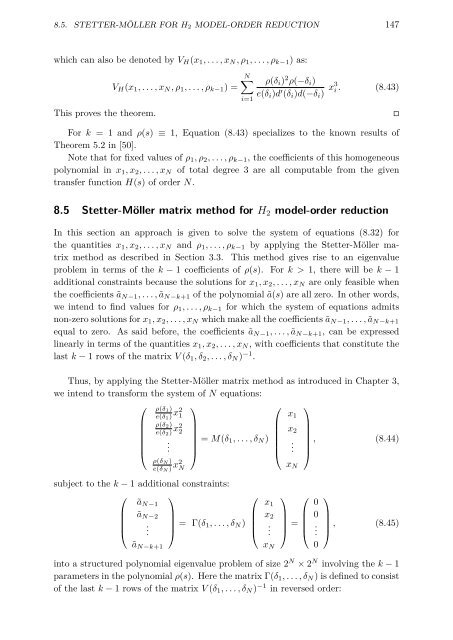link to my thesis
link to my thesis
link to my thesis
You also want an ePaper? Increase the reach of your titles
YUMPU automatically turns print PDFs into web optimized ePapers that Google loves.
8.5. STETTER-MÖLLER FOR H 2 MODEL-ORDER REDUCTION 147<br />
which can also be denoted by V H (x 1 ,...,x N ,ρ 1 ,...,ρ k−1 ) as:<br />
This proves the theorem.<br />
V H (x 1 ,...,x N ,ρ 1 ,...,ρ k−1 )=<br />
N∑<br />
i=1<br />
ρ(δ i ) 2 ρ(−δ i )<br />
e(δ i )d ′ (δ i )d(−δ i ) x3 i . (8.43)<br />
For k = 1 and ρ(s) ≡ 1, Equation (8.43) specializes <strong>to</strong> the known results of<br />
Theorem 5.2 in [50].<br />
Note that for fixed values of ρ 1 ,ρ 2 ,...,ρ k−1 , the coefficients of this homogeneous<br />
polynomial in x 1 ,x 2 ,...,x N of <strong>to</strong>tal degree 3 are all computable from the given<br />
transfer function H(s) of order N.<br />
8.5 Stetter-Möller matrix method for H 2 model-order reduction<br />
In this section an approach is given <strong>to</strong> solve the system of equations (8.32) for<br />
the quantities x 1 ,x 2 ,...,x N and ρ 1 ,...,ρ k−1 by applying the Stetter-Möller matrix<br />
method as described in Section 3.3. This method gives rise <strong>to</strong> an eigenvalue<br />
problem in terms of the k − 1 coefficients of ρ(s). For k>1, there will be k − 1<br />
additional constraints because the solutions for x 1 ,x 2 ,...,x N are only feasible when<br />
the coefficients ã N−1 ,...,ã N−k+1 of the polynomial ã(s) are all zero. In other words,<br />
we intend <strong>to</strong> find values for ρ 1 ,...,ρ k−1 for which the system of equations admits<br />
non-zero solutions for x 1 ,x 2 ,...,x N which make all the coefficients ã N−1 ,...,ã N−k+1<br />
equal <strong>to</strong> zero. As said before, the coefficients ã N−1 ,...,ã N−k+1 , can be expressed<br />
linearly in terms of the quantities x 1 ,x 2 ,...,x N , with coefficients that constitute the<br />
last k − 1 rows of the matrix V (δ 1 ,δ 2 ,...,δ N ) −1 .<br />
Thus, by applying the Stetter-Möller matrix method as introduced in Chapter 3,<br />
we intend <strong>to</strong> transform the system of N equations:<br />
⎛ ρ(δ 1) ⎞<br />
⎛ ⎞<br />
e(δ 1) x2 1<br />
x 1<br />
ρ(δ 2)<br />
e(δ 2) x2 2<br />
x 2<br />
= M(δ<br />
⎜<br />
⎝ .<br />
⎟ 1 ,...,δ N )<br />
⎜<br />
, (8.44)<br />
⎠<br />
⎝ .<br />
⎟<br />
⎠<br />
ρ(δ N )<br />
e(δ N ) x2 N<br />
subject <strong>to</strong> the k − 1 additional constraints:<br />
⎛ ⎞<br />
⎛<br />
ã N−1<br />
ã N−2<br />
⎜ . ⎟<br />
⎝ . ⎠ = Γ(δ 1,...,δ N ) ⎜<br />
⎝<br />
ã N−k+1<br />
x 1<br />
x 2<br />
.<br />
.<br />
x N<br />
x N<br />
⎞ ⎛<br />
⎟<br />
⎠ = ⎜<br />
⎝<br />
0<br />
0<br />
.<br />
.<br />
0<br />
□<br />
⎞<br />
⎟<br />
⎠ , (8.45)<br />
in<strong>to</strong> a structured polynomial eigenvalue problem of size 2 N × 2 N involving the k − 1<br />
parameters in the polynomial ρ(s). Here the matrix Γ(δ 1 ,...,δ N ) is defined <strong>to</strong> consist<br />
of the last k − 1 rows of the matrix V (δ 1 ,...,δ N ) −1 in reversed order:

















